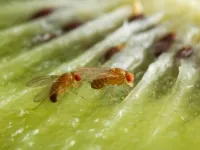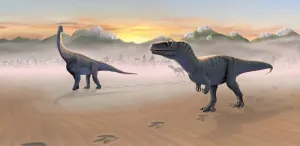(Press-News.org) For the first time researchers demonstrate in an animal how heavy alcohol use leads to long-term behavioral issues by damaging brain circuits critical for decision-making.
Rats exposed to high amounts of alcohol exhibited poor decision-making during a complex task even after a monthslong withdrawal period. Key areas of their brains had undergone dramatic functional changes compared to healthy rats.
The findings, published today in Science Advances, provide a new explanation of alcohol’s long-term effects on cognition.
“We now have a new model for the unfortunate cognitive changes that humans with alcohol use disorder show,” said author Patricia Janak, a Johns Hopkins University neuroscientist who studies the biology of addiction. “We know that humans who are addicted to alcohol can show deficits in learning and decision-making that may contribute to their poor decisions related to alcohol use. We needed an animal model to better understand how chronic alcohol abuse affects the brain. Knowing what is happening in the brain of an animal when they are having these decision-making difficulties will tell us what is happening in humans.”
In experiments led by first author Yifeng Cheng, a research scientist in Janak’s lab who studies alcohol’s effects on the brain, rats recieved very high alcohol exposure for a month. Then after a withdrawal period of nearly three months, the rats were given a reward-based decision-making test along with a control group of rats that had not been exposed to alcohol.
To get a reward, rats were given a choice of two levers. Pressing one lever led to a higher likelihood of reward than pressing the other lever. Rats easily learn which lever results in the most reward, so the researchers complicated things by every few minutes switching which lever had the highest reward likelihood. To get the most reward, a rat should rapidly change its behavior every time it figures out that the reward likelihood has changed.
It was a difficult task that required memory and strategy. The alcohol-exposed rats performed considerably worse.
Previous experiments in animals weren’t comparable to humans with alcohol use disorder because the animals didn’t demonstrate deficits in rapid decision-making. The team believes this was because tasks in earlier experiments were too easy.
“Our experiment was quite challenging and the alcohol-exposed rats just couldn’t do it as well,” Janak said. “When the right answer was constantly changing, the control rats made the best decisions faster. They were more strategic. And when we looked at their brains, the control rats’ decision-related neural signals were stronger.”
The team linked the behavioral difficulties to dramatic functional transformations in the dorsomedial striatum, a part of the brain critical for decision-making. The alcohol had damaged neural circuits causing alcohol-exposed rats to process information less effectively.
One surprise was how long alcohol dependence impairs cognition and neural function, even after withdrawal.
“This may give us insight into why relapse rates for people addicted to alcohol are so high,” Janak said. “Alcohol-induced neural deficits may contribute to decisions to drink even after going to rehab. We can clearly demonstrate these deficits can be long-lasting.”
The team only found the behavioral and neural impairments only in male rats. The team does not believe this suggests female rats are immune from the effects of alcohol, but that there could be sex-related sensitivities in long-term alcohol effects on brain function.
The researchers next hope to explore how alcoholism affects other areas of the brain that interact with the dorsomedial striatum, and what might be causing the differences between males and females.
Additional authors include Robin Magnard, a postdoctoral fellow at Johns Hopkins; Angela J. Langdon of the National Institutes of Health; and Daeyeol Lee, a Bloomberg Distinguished Professor of Neuroscience and Psychological and Brain Sciences at Johns Hopkins.
END
Study reveals how alcohol abuse damages cognition
Months after withdrawal, brain activity during decision-making remained impaired in rats
2025-04-02
ELSE PRESS RELEASES FROM THIS DATE:
Medicinal cannabis is linked to long-term benefits in health-related quality of life
2025-04-02
Patients prescribed medicinal cannabis in Australia maintained improvements in overall health-related quality of life (HRQL), fatigue, and sleep disturbance across a one-year period, according to a study published April 2, 2025, in the open-access journal PLOS One by Margaret-Ann Tait from The University of Sydney, Australia, and colleagues. Anxiety, depression, insomnia, and pain also improved over time for those with corresponding health conditions.
Research into the therapeutic benefits of medicinal cannabis has increased since the discovery of the analgesic properties in cannabis plant compounds. In 2016, advocacy groups lobbied the Australian government to ...
Microplastics detected in cat placentas and fetuses during early pregnancy
2025-04-02
In a small study of eight cats at early stages of pregnancy, researchers detected 19 different kinds of microplastic particles in fetuses from two cats and in the placentas of three cats. Ilaria Ferraboschi of the University of Parma, Italy, and colleagues present these findings in the open-access journal PLOS One on April 2, 2025.
Humans and other animals worldwide are increasingly exposed to microplastics, which are small particles of plastic contaminants. Studies suggest that microplastics can have a variety of adverse health effects. For instance, research in rodents suggests that fetuses exposed to microplastics ...
Ancient amphibians as big as alligators died in mass mortality event in Triassic Wyoming
2025-04-02
Dozens of amphibians perished together on an ancient floodplain around 230 million years ago, according to a study published April 2, 2025 in the open-access journal PLOS One by Aaron M. Kufner of the University of Wisconsin-Madison, U.S., and colleagues.
Early in the Age of Dinosaurs, alligator-sized amphibians called metoposaurid temnospondyls were common in freshwater habitats. Several fossil sites contain large concentrations of temnospondyls buried together, but determining how these bonebeds formed is often difficult due to ...
Scientists uncover the first clear evidence of air sacs in the fossilized bones of alvarezsaurian dinosaurs: the "hollow bones" which help modern day birds to fly
2025-04-02
Article URL: https://plos.io/4hxJYYP
Article title: First unambiguous record of pneumaticity in the axial skeleton of alvarezsaurians (Theropoda: Coelurosauria)
Author countries: Argentina, China
Funding: We thank P. Chafrat from Museo Patagónico de Ciencias Naturales, General Roca, Río Negro Province, Argentina. The authors gratefully acknowledge "Fundacion Patagonica de Ciencias Naturales" and "Sanatorio Juan XXIII" for making the CT images possible. MP was supported by the Faculty of Science of The Chinese University of Hong Kong. We thank Hans-Dieter Sues, an anonymous reviewer, and the editorial team of PLOS ONE for their comments ...
Alcohol makes male flies sexy
2025-04-02
The fruit fly Drosophila melanogaster is also known as the pomace or vinegar fly. It can be found in large numbers in organic waste bins during the summer and in the fruit and vegetables section of grocery stores on hot days. It is attracted to the odor of pre-rotting fruit, where microorganisms, especially yeasts, have multiplied and invaded the fruit and switched their metabolism to alcoholic fermentation. This is why rotten fruit contains significant amounts of alcohol.
Alcohol consumption requires a risk assessment
There is no doubt that the consumption of large amounts of alcohol is harmful to human beings.. ...
TB patients globally often incur "catastrophic costs" of up to $11,329 USD, despite many countries offering free treatment, with predominant drivers of cost being hospitalization and loss of income
2025-04-02
TB patients globally often incur "catastrophic costs" of up to $11,329 USD, despite many countries offering free treatment, with predominant drivers of cost being hospitalization and loss of income.
####
Article URL: https://plos.io/3QXqJ07
Article Title: The catastrophic cost of TB care: Understanding costs incurred by individuals undergoing TB care in low-, middle-, and high-income settings – A systematic review
Author Countries: Canada, Eswatini, Germany, United States
Funding: The authors received no specific funding for ...
Study links teen girls’ screen time to sleep disruptions and depression
2025-04-02
Excessive screen time among adolescents negatively impacts multiple aspects of sleep, which in turn increases the risk of depressive symptoms — particularly among girls. That is the conclusion of a new study published this week in the open-access journal PLOS Global Public Health by Sebastian Hökby of Karolinska Institutet, Sweden, and colleagues.
Recently, the Swedish Public Health Agency published recommendations that adolescents use no more than two-to-three hours of daily leisure screen time, partly to promote better sleep. ...
Scientists unveil starfish-inspired wearable tech for heart monitoring
2025-04-02
When we move, it’s harder for existing wearable devices to accurately track our heart activity. But University of Missouri researchers found that a starfish’s five-arm shape helps solve this problem.
Inspired by how a starfish flips itself over — shrinking one of its arms and using the others in a coordinated motion to right itself — Sicheng Chen and Zheng Yan in Mizzou’s College of Engineering and collaborators have created a starfish-shaped wearable device that tracks heart health in real time.
Because the starfish-inspired device has multiple points touching the skin near the heart, it stays more ...
Footprints reveal prehistoric Scottish lagoons were stomping grounds for giant Jurassic dinosaurs
2025-04-02
Jurassic dinosaurs milled about ancient Scottish lagoons, leaving up to 131 footprints at a newly discovered stomping ground on the Isle of Skye in Scotland, according to a study published April 2, 2025 in the open-access journal PLOS One by Tone Blakesley of the University of Edinburgh, Scotland and colleagues.
In the rocks of the Isle of Skye, dinosaur footprints are abundant, providing insights into dinosaur distribution and behavior during an important time in their evolution. The footprints were left in the rippled sands of an ancient subtropical lagoon, dating back to the Middle Jurassic ...
AI effectively predicts dementia risk in American Indian/Alaska Native elders
2025-04-02
Irvine, Calif., April 2, 2025 — Machine learning algorithms utilizing electronic health records can effectively predict two-year dementia risk among American Indian/Alaska Native adults aged 65 years and older, according to a University of California, Irvine-led study. The findings provide a valuable framework for other healthcare systems, particularly those serving resource-limited populations.
The computer modeling results also found several new predictors for dementia diagnosis that were identified consistently across different machine-learning models. Findings are published in the Lancet Regional Health – Americas. The National Institutes ...
LAST 30 PRESS RELEASES:
Scalable and healable gradient textiles for multi‑scenario radiative cooling via bicomponent blow spinning
Research shows informed traders never let a good climate crisis go to waste
Intelligent XGBoost framework enhances asphalt pavement skid resistance assessment
Dual-function biomaterials for postoperative osteosarcoma: Tumor suppression and bone regeneration
New framework reveals where transport emissions concentrate in Singapore
NTP-enhanced lattice oxygen activation in Ce-Co catalysts for low-temperature soot combustion
Synergistic interface engineering in Cu-Zn-Ce catalysts for efficient CO2 hydrogenation to methanol
COVID-19 leaves a lasting mark on the human brain
Scientists use ultrasound to soften and treat cancer tumors without damaging healthy tissue
Community swimming program for Black youth boosts skills, sense of belonging, study finds
Specific depressive symptoms in midlife linked to increased dementia risk
An ‘illuminating’ design sheds light on cholesterol
Who is more likely to get long COVID?
Study showcases resilience and rapid growth of “living rocks”
Naval Research Lab diver earns Office of Naval Research 2025 Sailor of the Year
New Mayo-led study establishes practical definition for rapidly progressive dementia
Fossil fuel industry’s “climate false solutions” reinforce its power and aggravate environmental injustice
Researchers reveal bias in a widely used measure of algorithm performance
Alcohol causes cancer. A study from IOCB Prague confirms damage to DNA and shows how cells defend against it
Hidden viruses in wastewater treatment may shape public health risks, study finds
Unlock the power of nature: how biomass can transform climate mitigation
Biochar reshapes hidden soil microbes that capture carbon dioxide in farmland
Reducing saturated fat intake shows mortality benefit, but only in high-risk individuals
Manta rays create mobile ecosystems, study finds
Study: Mixed results in using lipoic acid to treat progressive multiple sclerosis
Norbert Holtkamp appointed director of Fermi National Accelerator Laboratory
New agentic AI platform accelerates advanced optics design
Biologists discover neurons use physical signals — not electricity — to stabilize communication
Researchers discover that a hormone can access the brain by hitchhiking
University of Oklahoma researcher awarded funding to pursue AI-powered material design
[Press-News.org] Study reveals how alcohol abuse damages cognitionMonths after withdrawal, brain activity during decision-making remained impaired in rats








